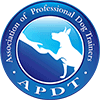
Training Philosophy
We follow the Least Intrusive, Minimally Aversive (LIMA) training approach, briefly summarized below.
Dogs like goodies, like a favorite toy or treat. They also like praise, and can solve problems at somewhere around the level of a 2-year old human.
Using these simple facts, our training
is based on:
- Giving positive rewards (e.g., goodies and praise) for doing what we asked (i.e., responding to a cue word)
- Saying 'Oops!' or an 'Uh oh' (or often, just silence) for not doing what we asked, and
- Working with our thinking dog to help them solve the problem of getting more of (A)
and less of (B).
Sound silly? But try looking at it from your dog's viewpoint:
Sometimes I get a great piece of chicken and lots of happy words, but other times I get no chicken and not happy words. I really don't know why either happens, but I'm sure gonna try to figure out what to do to get that chicken and those happy words!
Suppose instead a dog gets nothing when she does the 'right' thing, and yelled at (or worse) when she does the 'wrong' thing - what might she think then?
Sometimes my person ignores me or maybe gives me a couple nice words. Other times, I get yelled at and it makes me cringe. I really don't know why either happens, but I would sure like to figure out what not to do so I don't get yelled at. But there are so many things I do in a day, it's really hard to figure out what one thing not to do. Some days, I think I should just hide in a corner and not do anything at all so I don't get yelled at.
Which way do you think you would learn quicker and better, not to mention with more fun?
Teaching our students about how their dog thinks is another key part of our training philosophy. So we begin our Foundation class with learning how to understand what our dogs are already telling us.
When you think about it, most of the time, our dogs lie around studying us for clues about what is going to happen next (and is that going to be something good or bad for them).
So why not tap into this knowledge our dogs already have about us when we want to teach them something? We can then build on that knowledge to teach them the cues they need to know to get around in OUR world.
Bella

Miss Bella has turned out to be a great winner of a girl!
It took me 10 min. with the clicker and treats to teach her how to close cupboard doors and even drawers.
So this winter I taught her how to close the back door and she got it in no time .
Now she will close it: You just have to ask her and give her a treat!
She is also a great leash walker. When I say "Oops", she runs behind me on the left side!
Even if shes really far, I'll yell "Oops" and she runs like lightning, grass and dirt flying behind her and into position she goes! Yeaaaaaaa!
- Val Z.
Bonnie

I like how Mike briefly explains the theory behind a certain cue, then demonstrates it with Bonnie a couple of times, then allows me to do the exercise a few times while he comments, giving me pointers on how to do better.
I also like the way Mike always did the classes, treating my dogs so kindly during training sessions and after. They really responded well to Mike!
- Virginia T.
